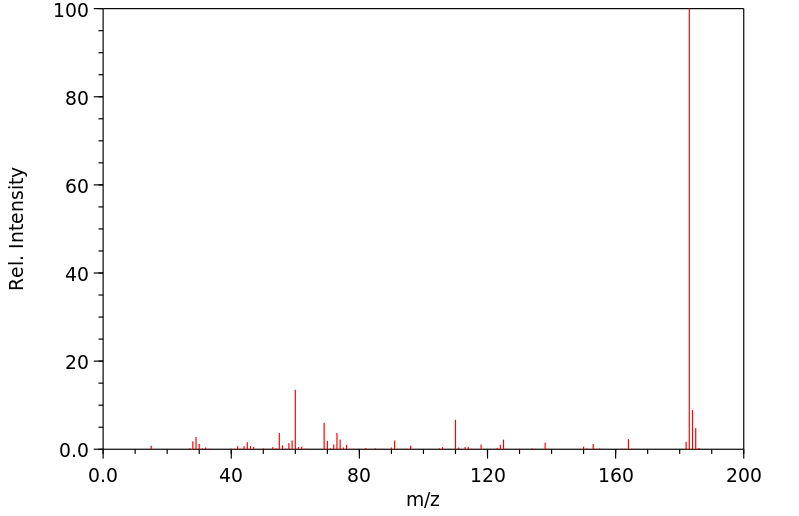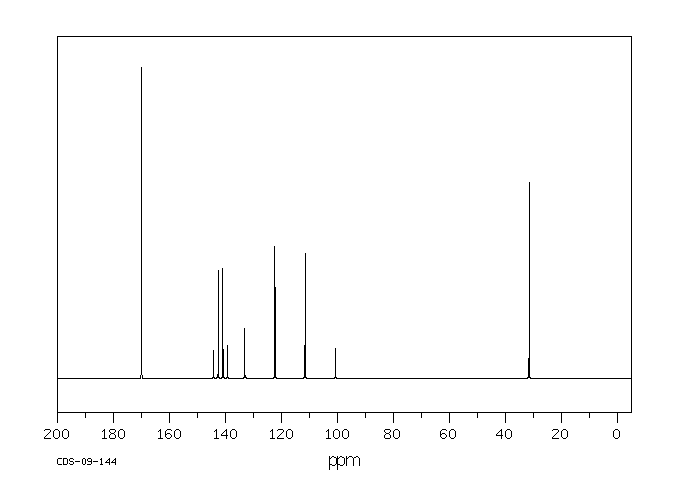4-甲基-5-三氟甲基-1,2,4-三唑-3-硫酮 | 30682-81-6
中文名称
4-甲基-5-三氟甲基-1,2,4-三唑-3-硫酮
中文别名
4-甲基-5-三氟甲基-4H-1,2,4-三唑-3(2H)-硫酮;4-甲基-5-三氟甲基-1,2,4-噻唑烷-3(2h)-硫酮;4-甲基-5-三氟甲基-1,2,4-三噁唑-3-硫酮
英文名称
3-(trifluoromethyl)-4-methyl-4H-1,2,4-triazole-3-thiol
英文别名
3-mercapto-4-methyl-5-(trifluoromethyl)-4H-1,2,4-triazole;5-mercapto-1-methyl-2-trifluoromethyl-1,3,4-triazole;4-methyl-5-trifluoromethyl-4H-1,2,4-triazoline-3(2H)-thione;4-methyl-5-(trifluoromethyl)-4H-1,2,4-triazole-3-thiol;5-Mercapto-4-methyl-3-trifluoromethyl-4H-1,2,4-triazole;4-methyl-3-(trifluoromethyl)-1,2,4-triazole-5-thiol;sb00671;Hmftzt;4-methyl-3-(trifluoromethyl)-1H-1,2,4-triazole-5-thione
CAS
30682-81-6
化学式
C4H4F3N3S
mdl
MFCD00128161
分子量
183.157
InChiKey
HUZASKHMPBJXJP-UHFFFAOYSA-N
BEILSTEIN
——
EINECS
——
-
物化性质
-
计算性质
-
ADMET
-
安全信息
-
SDS
-
制备方法与用途
-
上下游信息
-
文献信息
-
表征谱图
-
同类化合物
-
相关功能分类
-
相关结构分类
物化性质
-
熔点:116-118 °C
-
密度:1.5014 (estimate)
-
稳定性/保质期:
常温常压下稳定。
计算性质
-
辛醇/水分配系数(LogP):1.1
-
重原子数:11
-
可旋转键数:0
-
环数:1.0
-
sp3杂化的碳原子比例:0.5
-
拓扑面积:59.7
-
氢给体数:1
-
氢受体数:5
安全信息
-
危险品标志:Xi
-
危险类别码:R36/37/38
-
海关编码:2933990090
-
安全说明:S16,S22,S26,S36/37/39
SDS
| Name: | 4-Methyl-5-trifluoromethyl-4H-1 2 4-triazolin-3(2H)-thione 98% Material Safety Data Sheet |
| Synonym: | 2,4-Dihydro-4-methyl-5-(trifluoromethyl)-3H-1,2,4-triazole-3-thion |
| CAS: | 30682-81-6 |
Synonym:2,4-Dihydro-4-methyl-5-(trifluoromethyl)-3H-1,2,4-triazole-3-thion
Section 2 - COMPOSITION, INFORMATION ON INGREDIENTS
| CAS# | Chemical Name | content | EINECS# |
| 30682-81-6 | 4-Methyl-5-trifluoromethyl-4H-1,2,4-tr | 98 | 250-288-9 |
Risk Phrases: None Listed.
Section 3 - HAZARDS IDENTIFICATION
EMERGENCY OVERVIEW
The toxicological properties of this material have not been fully investigated.
Potential Health Effects
Eye:
May cause eye irritation.
Skin:
May cause skin irritation.
Ingestion:
May cause irritation of the digestive tract. The toxicological properties of this substance have not been fully investigated.
Inhalation:
May cause respiratory tract irritation. The toxicological properties of this substance have not been fully investigated.
Chronic:
No information found.
Section 4 - FIRST AID MEASURES
Eyes: Flush eyes with plenty of water for at least 15 minutes, occasionally lifting the upper and lower eyelids. Get medical aid.
Skin:
Get medical aid. Flush skin with plenty of water for at least 15 minutes while removing contaminated clothing and shoes. Wash clothing before reuse.
Ingestion:
Never give anything by mouth to an unconscious person. Get medical aid. Do NOT induce vomiting. If conscious and alert, rinse mouth and drink 2-4 cupfuls of milk or water.
Inhalation:
Remove from exposure and move to fresh air immediately. If not breathing, give artificial respiration. If breathing is difficult, give oxygen. Get medical aid.
Notes to Physician:
Section 5 - FIRE FIGHTING MEASURES
General Information:
As in any fire, wear a self-contained breathing apparatus in pressure-demand, MSHA/NIOSH (approved or equivalent), and full protective gear. During a fire, irritating and highly toxic gases may be generated by thermal decomposition or combustion.
Extinguishing Media:
Use water spray, dry chemical, carbon dioxide, or appropriate foam.
Section 6 - ACCIDENTAL RELEASE MEASURES
General Information: Use proper personal protective equipment as indicated in Section 8.
Spills/Leaks:
Sweep up, then place into a suitable container for disposal. Avoid generating dusty conditions. Provide ventilation.
Section 7 - HANDLING and STORAGE
Handling:
Wash thoroughly after handling. Remove contaminated clothing and wash before reuse. Use with adequate ventilation. Minimize dust generation and accumulation. Avoid contact with eyes, skin, and clothing. Avoid ingestion and inhalation.
Storage:
Store in a tightly closed container. Store in a cool, dry, well-ventilated area away from incompatible substances.
Section 8 - EXPOSURE CONTROLS, PERSONAL PROTECTION
Engineering Controls:
Facilities storing or utilizing this material should be equipped with an eyewash facility and a safety shower. Use adequate ventilation to keep airborne concentrations low.
Exposure Limits CAS# 30682-81-6: Personal Protective Equipment Eyes: Wear appropriate protective eyeglasses or chemical safety goggles as described by OSHA's eye and face protection regulations in 29 CFR 1910.133 or European Standard EN166.
Skin:
Wear appropriate protective gloves to prevent skin exposure.
Clothing:
Wear appropriate protective clothing to prevent skin exposure.
Respirators:
A respiratory protection program that meets OSHA's 29 CFR 1910.134 and ANSI Z88.2 requirements or European Standard EN 149 must be followed whenever workplace conditions warrant respirator use.
Section 9 - PHYSICAL AND CHEMICAL PROPERTIES
Physical State: Crystalline powder
Color: light yellow
Odor: None reported.
pH: Not available.
Vapor Pressure: Not available.
Viscosity: Not available.
Boiling Point: Not available.
Freezing/Melting Point: 116.00 - 118.00 deg C
Autoignition Temperature: Not applicable.
Flash Point: Not applicable.
Explosion Limits, lower: Not available.
Explosion Limits, upper: Not available.
Decomposition Temperature: Not available.
Solubility in water: Not available.
Specific Gravity/Density: Not available.
Molecular Formula: C4H4F3N3S
Molecular Weight: 183.15
Section 10 - STABILITY AND REACTIVITY
Chemical Stability:
Stable under normal temperatures and pressures.
Conditions to Avoid:
Incompatible materials, strong oxidants.
Incompatibilities with Other Materials:
Oxidizing agents.
Hazardous Decomposition Products:
Nitrogen oxides, carbon monoxide, oxides of sulfur, irritating and toxic fumes and gases, carbon dioxide, hydrogen fluoride gas, nitrogen.
Hazardous Polymerization: Has not been reported.
Section 11 - TOXICOLOGICAL INFORMATION
RTECS#:
CAS# 30682-81-6 unlisted.
LD50/LC50:
Not available.
Carcinogenicity:
4-Methyl-5-trifluoromethyl-4H-1,2,4-triazolin-3(2H)-thione - Not listed by ACGIH, IARC, or NTP.
Section 12 - ECOLOGICAL INFORMATION
Section 13 - DISPOSAL CONSIDERATIONS
Dispose of in a manner consistent with federal, state, and local regulations.
Section 14 - TRANSPORT INFORMATION
IATA
Not regulated as a hazardous material.
IMO
Not regulated as a hazardous material.
RID/ADR
Not regulated as a hazardous material.
Section 15 - REGULATORY INFORMATION
European/International Regulations
European Labeling in Accordance with EC Directives
Hazard Symbols: Not available.
Risk Phrases:
Safety Phrases:
S 24/25 Avoid contact with skin and eyes.
WGK (Water Danger/Protection)
CAS# 30682-81-6: No information available.
Canada
None of the chemicals in this product are listed on the DSL/NDSL list.
CAS# 30682-81-6 is not listed on Canada's Ingredient Disclosure List.
US FEDERAL
TSCA
CAS# 30682-81-6 is not listed on the TSCA inventory.
It is for research and development use only.
SECTION 16 - ADDITIONAL INFORMATION
N/A
上下游信息
-
下游产品
中文名称 英文名称 CAS号 化学式 分子量 —— 4-methyl-5-trifluoromethyl-2,4-dihydro-3H-1,2,4-triazol-3-one 51856-10-1 C4H4F3N3O 167.09
反应信息
-
作为反应物:描述:4-甲基-5-三氟甲基-1,2,4-三唑-3-硫酮 在 potassium carbonate 作用下, 以 乙腈 为溶剂, 生成 N-(3-chlorophenyl)-2-{[4-methyl-5-trifluoromethyl-4H-1,2,4-triazol-3-yl]sulfanyl}acetamide参考文献:名称:Identifying new lead structures to enhance tolerance towards drought stress via high-throughput screening giving crops a quantum of solace摘要:Novel synthetic lead structures interacting with RCAR/(PYR/PYL) receptor proteins were identified based on the results of a high-throughput screening campaign of a large compound library followed by focused SAR studies of the three most promising hit clusters. Whilst indolinylmethyl sulfonamides 8y,z and phenylsulfonyl ethylenediamines 9y,z showed strong affinities for RCAR/ (PYR/PYL) receptor proteins in wheat, thiotriazolyl acetamides 7f,s exhibited promising efficacy against drought stress in vivo (wheat, corn and canola) combined with confirmed target interaction in wheat and arabidopsis thaliana. Remarkably, binding affinities of several representatives of 8 and 9 were on the same level or even better than the essential plant hormone abscisic acid (ABA).DOI:10.1016/j.bmc.2019.115142
-
作为产物:描述:参考文献:名称:Identifying new lead structures to enhance tolerance towards drought stress via high-throughput screening giving crops a quantum of solace摘要:Novel synthetic lead structures interacting with RCAR/(PYR/PYL) receptor proteins were identified based on the results of a high-throughput screening campaign of a large compound library followed by focused SAR studies of the three most promising hit clusters. Whilst indolinylmethyl sulfonamides 8y,z and phenylsulfonyl ethylenediamines 9y,z showed strong affinities for RCAR/ (PYR/PYL) receptor proteins in wheat, thiotriazolyl acetamides 7f,s exhibited promising efficacy against drought stress in vivo (wheat, corn and canola) combined with confirmed target interaction in wheat and arabidopsis thaliana. Remarkably, binding affinities of several representatives of 8 and 9 were on the same level or even better than the essential plant hormone abscisic acid (ABA).DOI:10.1016/j.bmc.2019.115142
文献信息
-
[EN] 4-PIPERAZINYL-PYRIMIDINE COMPOUNDS SUITABLE FOR TREATING DISORDERS THAT RESPOND TO MODULATION OF THE DOPAMINE D3 RECEPTOR<br/>[FR] COMPOSÉS DE 4-PIPÉRAZINYLPYRIMIDINE CONVENANT POUR TRAITER DES TROUBLES QUI RÉPONDENT À UNE MODULATION DU RÉCEPTEUR D3 DE LA DOPAMINE申请人:ABBOTT GMBH & CO KG公开号:WO2006015842A1公开(公告)日:2006-02-16The present invention relates to novel 4-piperazinylpyrimidine compounds. The compounds possess valuable therapeutic properties and are suitable, in particular, for treating diseases that respond to modulation of the dopamine D3 receptor. The 4 piperzinylpyrimidine compounds have the general formula (I), wherein Ar, X, A, R1 and R1a are as defined in the claims.
-
Process for the preparation of triazolinones申请人:Bayer Aktiengesellschaft公开号:US05475115A1公开(公告)日:1995-12-12The invention relates to a new process and new intermediates for the preparation of triazolinones of the general formula (I) ##STR1## in which R.sup.1 represents in each case optionally substituted alkyl or cycloalkyl and R.sup.2 represents amino or in each case optionally substituted alkyl, alkenyl, alkinyl, alkoxy, alkylamino, dialkylamino, cycloalkyl, cycloalkylalkyl or phenyl, and to new intermediates for the preparation of triazolinones, many of which are known and which can be used as intermediates for the preparation of herbicides and insecticides.
-
Process and intermediates for the preparation of triazolinones申请人:Bayer Aktiengesellschaft公开号:US05508420A1公开(公告)日:1996-04-16The invention relates to a new process and to new intermediates for the preparation of triazolinones, most of which are known, of the general formula (I) ##STR1## in which R.sup.1 and R.sup.2 have the meanings given in the application, and which can be used as intermediates for the preparation of herbicides and insecticides.
-
New 1-(heterocyclylalkyl)-4-(propionanilido)-4-piperidinyl methyl ester and methylene methyl ether analgesics作者:Jerome R. Bagley、Sheela A. Thomas、Frieda G. Rudo、H. Kenneth Spencer、Brian M. Doorley、Michael H. Ossipov、Thomas P. Jerussi、Mark J. Benvenga、Theodore SpauldingDOI:10.1021/jm00106a051日期:1991.2bulkier aromatic ring systems than the corresponding components of the arylethyl groups of the prototypic methyl ester (carfentanil, 2) and methylene methyl ether (sufentanil, 3 and alfentanil, 4) 4-propionanilido analgesics. Compound 9A (methyl 1-[2-(1H-pyrazol-1-yl)-ethyl]-4-[(1-oxopropyl)phenylamino]-4- piperidinecarboxylate), which exhibited appreciable mu-opioid receptor affinity, was a more potent已经合成了一系列新的1-(杂环烷基)-4-(丙酰胺基)-4-哌啶基甲基酯和亚甲基甲基醚,并进行了药理学评估。在小鼠热板试验中,大多数化合物的镇痛效果(ED50低于1 mg / kg)优于吗啡。这些研究表明,与原型甲基酯(卡芬太尼,2)和亚甲基甲基醚(舒芬太尼,3和阿芬太尼,4)4的芳基乙基的相应组分相比,其结构上更多样化和更庞大的芳环体系具有药理学适应性4-丙酸安宁镇痛药。表现出明显的阿片类受体亲和力的化合物9A(1- [2-(1H-吡唑-1-基)-乙基] -4-[(1-氧丙基)苯基氨基] -4-哌啶羧酸甲酯)强效和短效止痛药,比阿芬太尼具有更少的大鼠呼吸抑制作用。另一方面,邻苯二甲酰亚胺57A和57B对与伤害性传递的介导相关的阿片受体(例如,mu-,kappa-和delta-亚型)表现出微不足道的亲和力,在所有抗伤害感受试验中均显示出镇痛效果。此外,尽管57B与临床阿片类药物相比,在大鼠
-
Copper(I) Halide Complexes with 1,3-Propanebis(diphenylphosphine) and Heterocyclic Thione Ligands: Crystal and Electronic Structures (DFT) of [CuCl(pymtH)(dppp)], [CuBr(pymtH)(dppp)], and [Cu(<i>μ</i>-I)(dppp)]<sub>2</sub>作者:Paraskevas Aslanidis、Philip J. Cox、Savvas Divanidis、Athanassios C. TsipisDOI:10.1021/ic025896i日期:2002.12.1pi-type MOs delocalized over the entire four-membered Cu(mu-X)(2)Cu ring, which supports a ring current and could probably account for the nearly equivalent Cu-X bonds in the rhombus. Moreover, all [Cu(mu-X)(PH(3))(2)](2) dimers exhibit a sigma-type MO corresponding to weak Cu.Cu interactions supporting through-ring intermetallic interactions, which seems to be responsible for the stabilization of the otherwise氯化铜或溴化铜与等摩尔量的双磷配体1,3-丙烷双(二苯基膦)和杂环硫酮(L)在乙腈/甲醇溶剂中的反应得到[CuX(dppp)(L)类型的单核络合物],其中二膦配体充当螯合配体。相反,在相同条件下,碘化铜(I)生成二聚体复合物[Cu(mu-I)(dppp)](2),其中包含双桥碘配体。三种配合物的结构,[CuCl(pymtH)(dppp)],[CuCl(pymtH)(dppp)]和[Cu(mu-I)(dppp)](2)已通过单-晶体X射线衍射。在B3LYP理论水平上的密度泛函计算为[CuX(PH(3))(2)]和[CuX(1,3-pdp)]的结构,键合,电子和相关属性提供了令人满意的描述( 1,3-pdp = 1 3-丙烷-二膦)配合物及其二聚体以及与嘧啶-2-硫酮(pymtH)配体的缔合。pymtH配体与这些配合物中Cu(I)金属中心的相互作用对应于松散的缔合,对于该系列中的所有配合物,计算得出的相互作用能预计约为20
表征谱图
-
氢谱1HNMR
-
质谱MS
-
碳谱13CNMR
-
红外IR
-
拉曼Raman
-
峰位数据
-
峰位匹配
-
表征信息
同类化合物
(SP-4-1)-二氯双(1-苯基-1H-咪唑-κN3)-钯
(5aS,6R,9S,9aR)-5a,6,7,8,9,9a-六氢-6,11,11-三甲基-2-(2,3,4,5,6-五氟苯基)-6,9-甲基-4H-[1,2,4]三唑[3,4-c][1,4]苯并恶嗪四氟硼酸酯
(5-氨基-1,3,4-噻二唑-2-基)甲醇
齐墩果-2,12-二烯[2,3-d]异恶唑-28-酸
黄曲霉毒素H1
高效液相卡套柱
非昔硝唑
非布索坦杂质Z19
非布索坦杂质T
非布索坦杂质K
非布索坦杂质E
非布索坦杂质D
非布索坦杂质67
非布索坦杂质65
非布索坦杂质64
非布索坦杂质61
非布索坦代谢物67M-4
非布索坦代谢物67M-2
非布索坦代谢物 67M-1
非布索坦-D9
非布索坦
非唑拉明
雷非那酮-d7
雷西那德杂质2
雷西纳德杂质L
雷西纳德杂质H
雷西纳德杂质B
雷西纳德
雷西奈德杂质
阿西司特
阿莫奈韦
阿考替胺杂质9
阿米苯唑
阿米特罗13C2,15N2
阿瑞匹坦杂质
阿格列扎
阿扎司特
阿尔吡登
阿塔鲁伦中间体
阿培利司N-1
阿哌沙班杂质26
阿哌沙班杂质15
阿可替尼
阿作莫兰
阿佐塞米
镁(2+)(Z)-4'-羟基-3'-甲氧基肉桂酸酯
锌1,2-二甲基咪唑二氯化物
锌(II)(苯甲醇)(四苯基卟啉)
锌(II)(正丁醇)(四苯基卟啉)
锌(II)(异丁醇)(四苯基卟啉)









